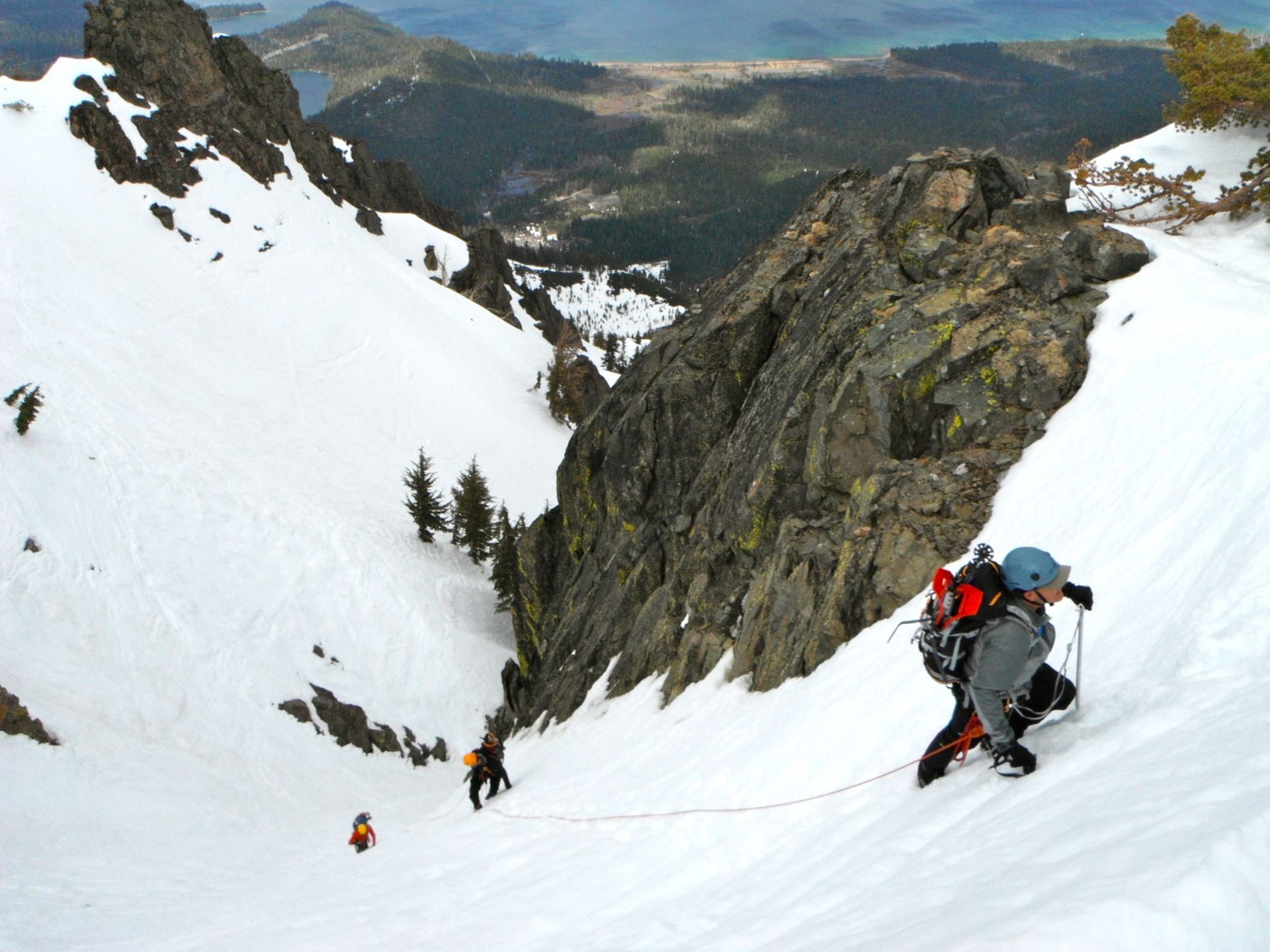
[MAA team on the Hotlum Glacier]
No we're not talking morbid tales of demise, but rather snow protection. What do you know about how to use pickets, a bollard, or a snow seat to give your team some security in that couloir / glacier / steep face?
Using specialized techniques and tools, any snow slope is not only climbable, but protectable. There are options beyond individual self-arrest, but it always involves a rope and some form of protection. But you can't just rope up like you would do at the rock crag and call it good. Climbing steep snow safely requires a bit more.
First, some understanding about protection. Generally, snow does not provide the best options...rock protection is generally the strongest protection available. Ironically, it should be your first choice on a snow climb. That's one reason why it's a good idea to climb on the side of a couloir. Next best option is an ice screw, if you can get it, but that's rare. Next best is probably a natural anchor such as a large, well-rooted tree or a very large boulder, flake, or horn.
If none of these options are available, then your next best strategies to protect yourself and the team on the climb are the usual tri-fecta of 1. snow protection, combined with 2. belayer positioning, and backed up by 3. an effective team self-arrest.
 [MAA team in the Cross Couloir on Mt. Tallac]
[MAA team in the Cross Couloir on Mt. Tallac]
I. Snow Protection
Pickets are the universal choice here. The standard 1.5 foot T-shaped aluminum snow picket can be hammered in vertically, like a fence post (as a "picket") or buried horizontally in a T-slot (as a "deadman"). You will need a double length (48") sling or an attached cable to extend it for anchoring.
Next best option is to use a mountain axe, also placed as a picket or a deadman, and you'll need to sling it as well by clipping to the head or using a girth hitch or clove hitch around the shaft. Once the axe is solid you can connect it to the picket(s) and begin creating your belay anchor.
Other options include a snow fluke, a bollard, or any other object of some size that can be used as a dead man, like skis, snowshoes, or a pack. To learn more about this paid members can view Snow 3 online training.
Snow flukes aren't used much because they only work well in a small range of snow conditions. They are a v-shaped plate of aluminum with a cable that is buried a foot or two in the snow. If weighted, the fluke travels deeper into the snowpack the more pressure it receives. If the snow is too loose it will pull out and if the snow is too dense, it won't move at all. (Perhaps it's best use is as a huge, flat chock placed behind a rock.)
A bollard is also not used much but is great to know about and fun to use, if you have the time to dig one. It is a tear-drop shaped trench that is dug in the snow where the rope can be placed so that is in effect "lassoes" a big circular plug of snow. A bollard requires some practice to do well, but does enable you to use it as an anchor, or even rappell from it, using nothing but snow. Not sure if that is encouraging or not!
II. Belayer Positioning
This is what's called a "snow seat". It is a way of anchoring oneself while seated in the snow, feet wide and braced, in order to provide more strength to an often dubious snow anchor. Most often it is used at the end of a lead to bring up the team, but it can be used at any time, even in rock climbing, to add to the overall strength of a belay anchor.
In snow climbing, if the team is belayed directly off the harness using a Munter Hitch, a device, or even a hip wrap, then the snow anchor components are usually equalized and the master point is attached to the belayer's belay loop to function as a backup to the snow seat.
In this way belaying a team on the snow is often different than rock climbing: the belayer's position is considered the primary strength of the anchor with the various snow anchors components factored in as additional strength, and the team is belayed from the harness instead of from the master point of the anchor.

[Team simul-climbing the Hotlum Left Ice Gully on Mt. Shasta]
III. Team Self-Arrest
Most of the time snow climbs are done using a technique called a running belay or "simul-climbing". This is a technique where the entire team is spread out on the rope and all moving at the same time. The leader places protection at regular intervals and the last person on the team removes it, taking care to keep a few pieces attached to the rope at all times.
If any member of the team falls everyone executes a self-arrest in response. This is the first line defense against injury. Secondly, the rope will come tight on the protection and that will add a level of security. But if protection fails, the team still has self-arrest as their primary risk management strategy. So as the first and the last resort, it must be done well!
Learn More - all of these skills and techniques are taught in our Snow 3 and Snow 4 training courses being held in April and May. You can also learn more by watching the online video training and we have some applicable seminars on our YouTube Channel.
Happy climbing!


